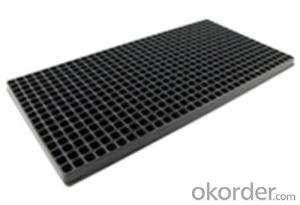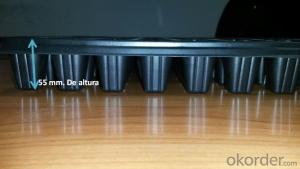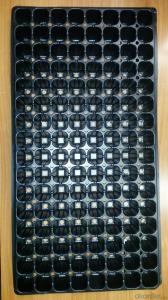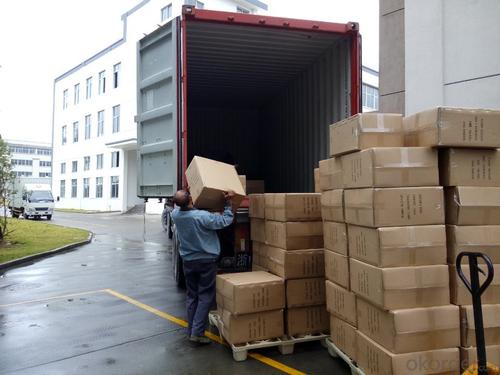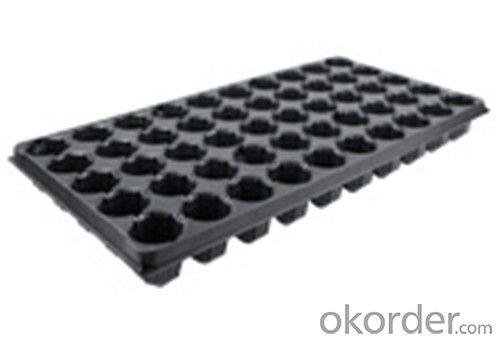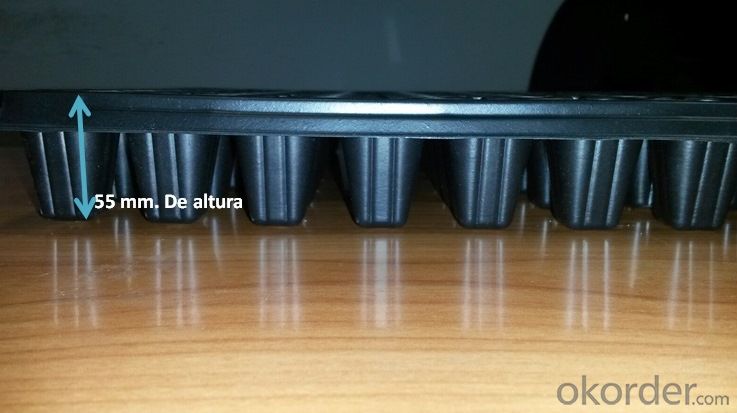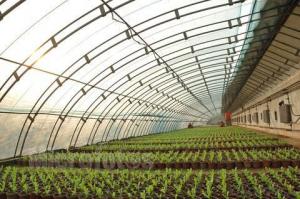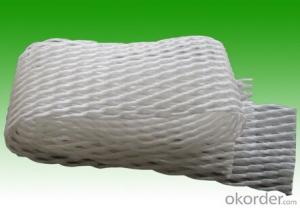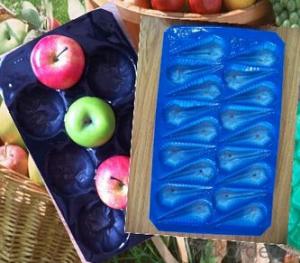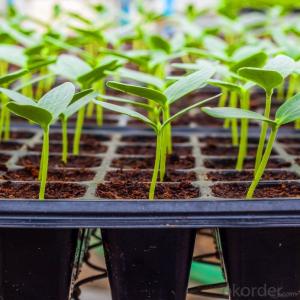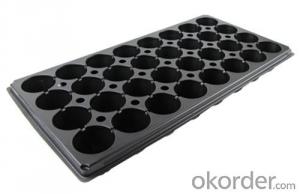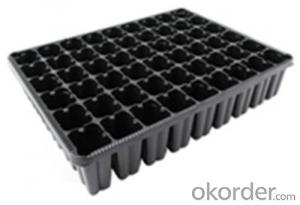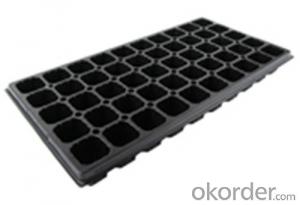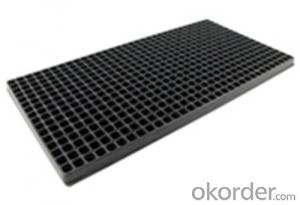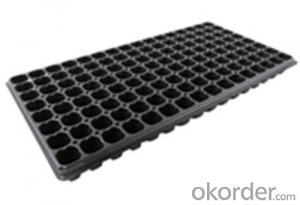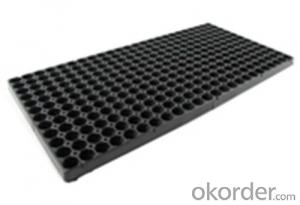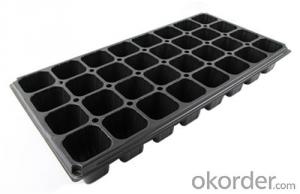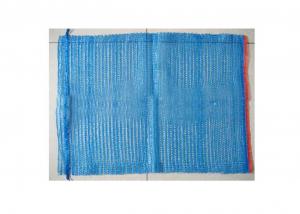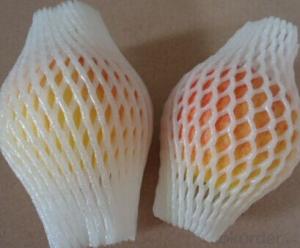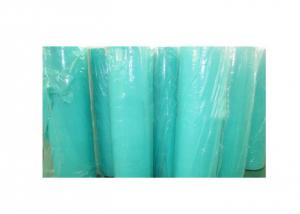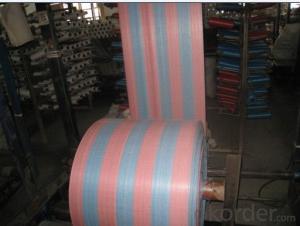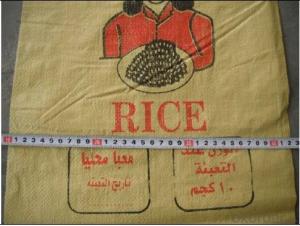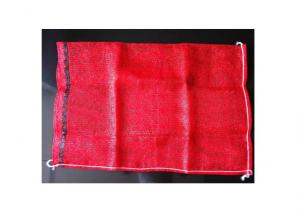Square Nursery Seeding Tray HIPS Seed Tray Plastic Tray
- Loading Port:
- China main port
- Payment Terms:
- TT OR LC
- Min Order Qty:
- 1000 pc
- Supply Capability:
- 10000000 pc/month
OKorder Service Pledge
OKorder Financial Service
You Might Also Like
Structure of the seed tray:
· Top quality and competitive price.
· Variety design and good appearance.
· Easy to use, and remove.
· Durable and reusable.
· Eco-Friendly.
Advantages:
· Top quality and competitive price.
· Variety design and good appearance.
· Easy to use, and remove.
· Durable and reusable.
· Eco-Friendly.
Application:
· Ideal for Starting seeds and Transplanting Seedling.
· Suitable for both manual and automatic planting.
· Suitable for Propagating Vegetables, Flowers and other plant from seed · in green-house or indoors.
Description Main Features of the seed tray:
· Ideal for Starting seeds and Transplanting Seedling.
· Suitable for both manual and automatic planting.
· Suitable for Propagating Vegetables, Flowers and other plant from seed in green-house or indoors.
Using time:
· thickness of 0.5mm can be used 1 to 2 times.
· thickness of 0.6mm can be used 3 to 4 times.
· thickness of 0.7mm can be used 5 to 6 times.
· thickness of 0.8mm can be used 7 to 8 times.
· thickness of 0.9mm can be used 8 to 9 times.
· thickness of 1.0mm can be used 8 to 10 times.
Thickness vs. Weight:
· Thickness of trays are from 0.5mm to 1.0mm.
· 1.0mm: 155g±5g; 100pcs/ctn.
· 0.9mm: 140g±5g; 120pcs/ctn.
· 0.7mm: 110g±5g; 150pcs/ctn.
· 0.6mm: 95g±5g; 180pcs/ctn.
· 0.5mm: 80g±5g; 200pcs/ctn.
Seed Tray Specification:
Material | ps/pvc |
Thickness | 0.5mm-1.5mm, standard:1mm |
Weight | 80g(±5)g-230g(±5)g, Standard weight:155g(±5)g |
Size | length:490mm-540mm, width:190mm-345mm,depth:25mm-150mm Standard:54mmX28mm |
Cell count | 18-512 |
Package | in carton |
Using time | 8-10 times |
FAQ:
Q:How Can I Get A Sample?
A:You can get samples by communicate with our export sales.
Q:How Long Is Delivery?
A:Delivery time will be 7-25 days according to order quantity.
Q:What Is The MOQ?
A:Our MOQ is 1*20FT container quantity, allow to mix several items.
Q:What Is Our Normal Payments Terms?
A:Our normal payment terms now is T/T, L/C or Western Union,Papal.
Q:How Do I Order Your Products?
A:You can check our website for any items you interest and you can also get communication with our export sales and order for it accordingly.
Q:What Kinds Of Material We Use In Our Product?
A:Our plastic flower pots use material such as PP polymer or PE polymer.
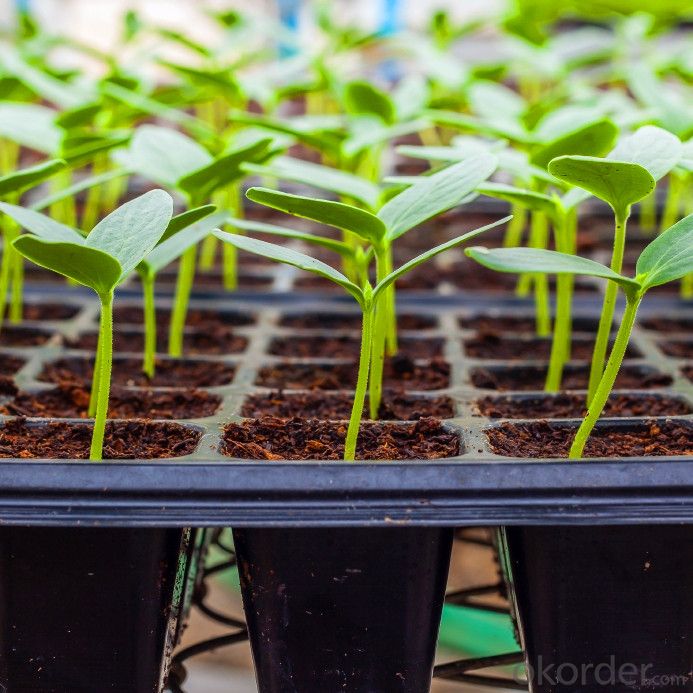
- Q: Can nursery trays be used for seedling transplanting?
- Yes, nursery trays can be used for seedling transplanting. They provide an organized and convenient way to start and grow seedlings before they are ready to be transplanted into larger pots or directly into the ground. Nursery trays are designed with individual compartments that help keep the seedlings separate and allow for easy transportation and handling during the transplanting process.
- Q: he always eats plastic containers. it doesn't do anything...just comes out his backside the next day lol. will it hurt him one day? he seems to enjoy it.......
- Don't know if it'll hurt him I'm afraid but I do know that our two puppies do the same with plastic, it just comes straight out though... Try teaching the drop command, it helps when you've caught them in the act :-) Also, just make sure you put EVERYTHING away or out of his reach so he can't get plastic in the first place e.g. also get metal food bowls etc. A good substitute is to get your dog raw hide shapes that he can chew on, it's got a really similar texture to plastic so he'll enjoy it but it doesn't do any damage to their little bodies, but make sure he has it on a special mat as it leaves white patches all over your carpet, then you can put the mat in the washing machine. If you get into a routine of giving the shapes to him at a particular time of day i.e. when you get home from work so you can supervise him keeping it on the doggy mat, then he'll learn not to chew anything else. Well, hope this helps-good luck!!!
- Q: is it against code to use regular plastic outlet electrical boxes for junction boxes?
- If the old fixture had the cable interior the fixture, then it became and nevertheless is interior of codes. the entire fixture is seen sufficient as an electric powered field. on your new fixture, you may want a connection field to offer appropriate mounting and cord termination.
- Q: What types of plastic containers are used for storing agricultural produce?
- Some common types of plastic containers used for storing agricultural produce include crates, bins, and tubs. These containers are typically made from high-density polyethylene (HDPE) or polypropylene (PP) plastics, which provide durability and resistance to moisture and chemicals. They are designed to protect the produce during transportation and storage, ensuring its quality and freshness.
- Q: Why is plastic important to know about?i don't mean why is it important, but why is plastic important to know. Thanks for helping.
- All good points! It's still a new invention, but it's impact on the economy and politics (even war), has been and continues to be, enormous.
- Q: Can ground cover be used to prevent soil compaction?
- Yes, ground cover can be used to prevent soil compaction. Ground cover plants, such as grasses and low-growing shrubs, can help protect the soil from the impact of heavy rain, footsteps, or machinery, reducing the risk of compaction. The plants' roots help bind the soil particles together, improving soil structure and stability. Additionally, the foliage of ground cover plants acts as a natural barrier, absorbing the impact energy and distributing it more evenly, further reducing soil compaction.
- Q: my sister started a recylce bin. we already recylce aluminum cans and pans, but what things to i recycle that are plastic and how do i? like what part of a plastic bottle do i discard?
- All plastics hence all the bottle can be recycled.
- Q: How does ground cover affect water conservation?
- Ground cover plays a crucial role in water conservation as it helps reduce soil erosion, retain moisture, and prevent water runoff. By creating a protective layer over the soil, ground cover minimizes evaporation and helps retain water in the ground, promoting healthy plant growth and reducing the need for irrigation. Additionally, ground cover plants with deep root systems can enhance soil structure and increase its ability to absorb and store water, thus improving overall water conservation efforts.
- Q: How does agricultural plastic affect crop root development?
- Agricultural plastic can have both positive and negative effects on crop root development. On one hand, plastic mulching can help create a favorable microclimate for root growth by conserving soil moisture and increasing soil temperature. This can result in enhanced root development and increased nutrient uptake, leading to improved crop yields. On the other hand, improper disposal or poor management of plastic materials can lead to negative consequences such as restricted root growth, decreased soil aeration, and hindered nutrient cycling. Therefore, careful and responsible use of agricultural plastic is essential to ensure its positive impact on crop root development.
- Q: How do agricultural plastic products help with pest exclusion?
- Agricultural plastic products help with pest exclusion by creating a physical barrier that prevents pests from accessing crops. These products, such as mulch films, greenhouse covers, and insect netting, effectively block insects, birds, and other pests from reaching the plants, reducing the risk of damage and crop loss.
Send your message to us
Square Nursery Seeding Tray HIPS Seed Tray Plastic Tray
- Loading Port:
- China main port
- Payment Terms:
- TT OR LC
- Min Order Qty:
- 1000 pc
- Supply Capability:
- 10000000 pc/month
OKorder Service Pledge
OKorder Financial Service
Similar products
Hot products
Hot Searches
Related keywords


